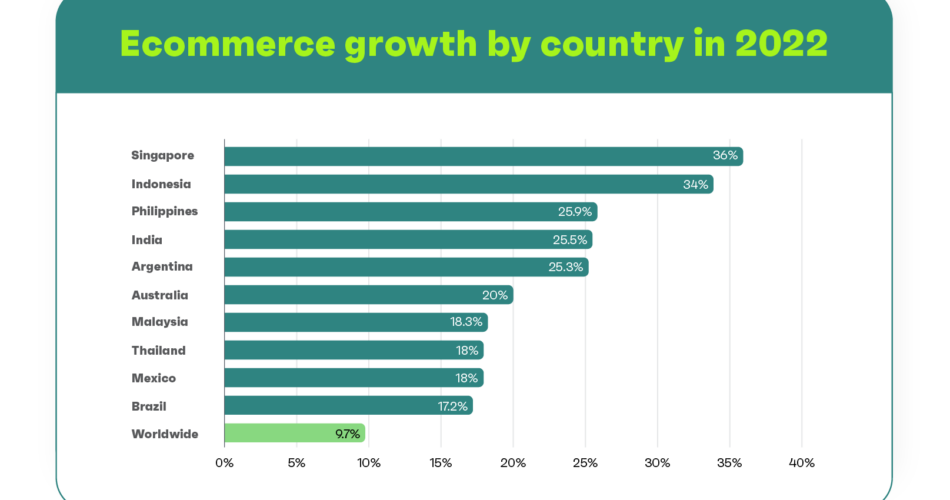The ecommerce landscape is constantly changing, and it can be tough to keep up with the latest trends in the industry. However, by understanding the latest ecommerce statistics, you can ensure that your ecommerce marketing strategy is on track and making the most impact.
For example, did you know that 85% of consumers abandoned their shopping carts in 2022? This highlights the importance of ensuring that your website is optimized to draw your visitors back to complete the purchase with compelling forms and popups.
Similarly, mobile commerce is on the rise, with more and more consumers using their smartphones and tablets to make purchases. In fact, three-quarters of all ecommerce traffic now comes from mobile devices! This trend is only set to continue, so it’s crucial that you make sure your website is mobile-friendly.
But why do you need to know the latest ecommerce statistics?
It’s simple—armed with these trends, businesses can make informed decisions about where to focus their efforts in order to maximize sales and ROI.
Data is also the key to staying one step ahead of the competition and ensuring you’re implementing the most effective ecommerce marketing strategies.
With this in mind, we’ve compiled a list of the most important ecommerce statistics for 2023 so that you can stay ahead of the curve.
Right from general ecommerce trends, beauty and fashion ecommerce insights, to and mobile ecommerce, we have covered the key statistics that matter.
So take some time to review them well and see how you can apply them to your own marketing strategy.
General ecommerce statistics
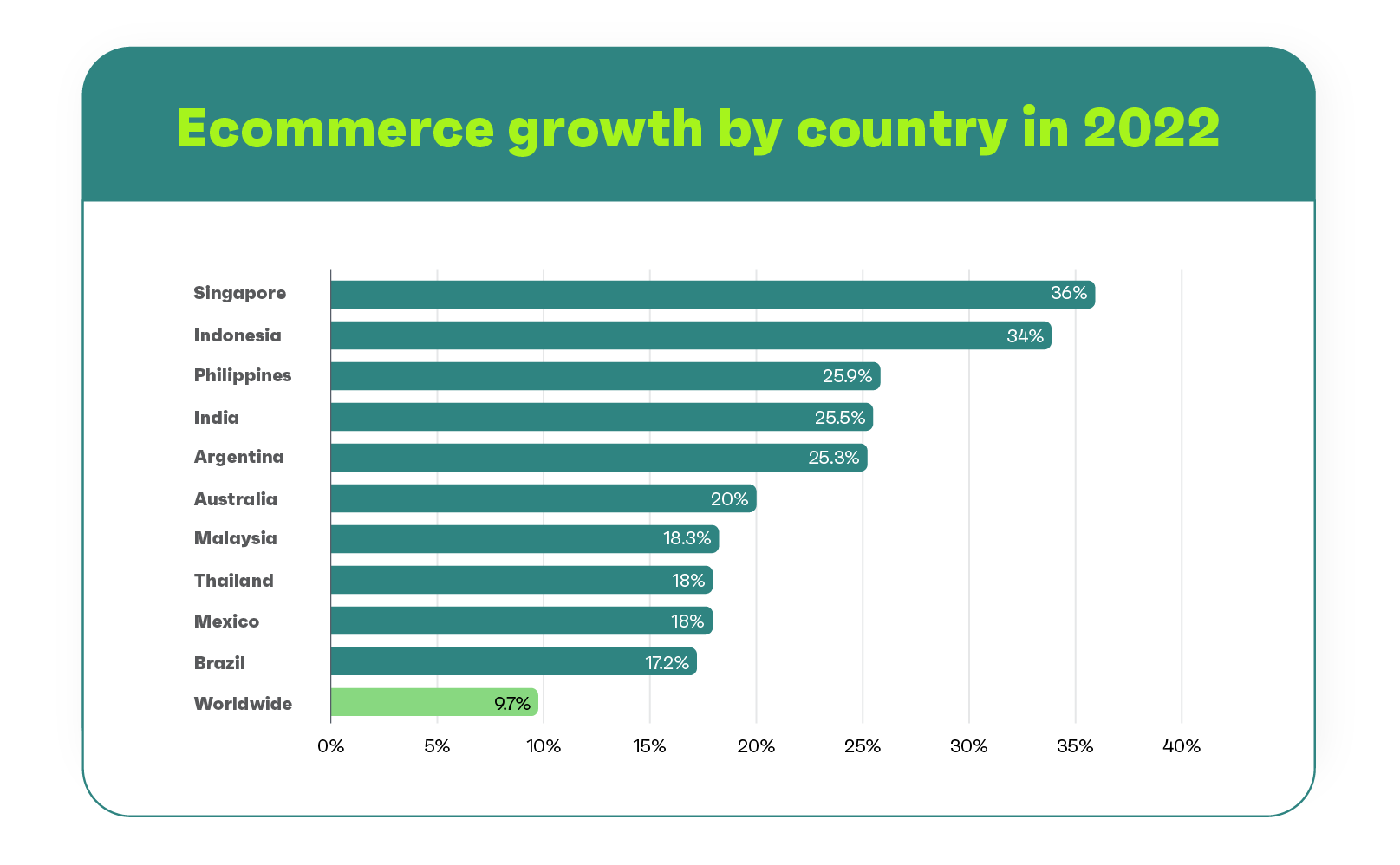
There’s no stopping the growth of ecommerce sales, with global online sales expected to reach a staggering $8.1 trillion by 2026.
Expectedly, as an increasing number of people around the world opt for online shopping, a quarter of all retail sales will come from ecommerce in the near future. While the competition between the two ecommerce giants, Alibaba and Amazon, continues to heat up, Amazon is slated to take over the top position by 2027, when it’s expected to generate $1.2 trillion in online sales.
What’s more?
According to the latest ecommerce stats, Asia has the highest ecommerce revenue at about $2 trillion, followed by the Americas and Africa. This is due to the rapid growth of economies in countries such as Singapore, India, and Indonesia, as well as the growing number of consumers in these countries who are increasingly turning to ecommerce platforms for buying products.
If you are looking to tap into this growing market, now is the time to start selling in Asia. With the right ecommerce platform and smart , you can reach a large audience of potential customers and make a significant amount of sales.
Finally, it’s expected that ecommerce will make up 25% of total global retail sales by 2026, up from 19% last year.
General ecommerce statistics for USA
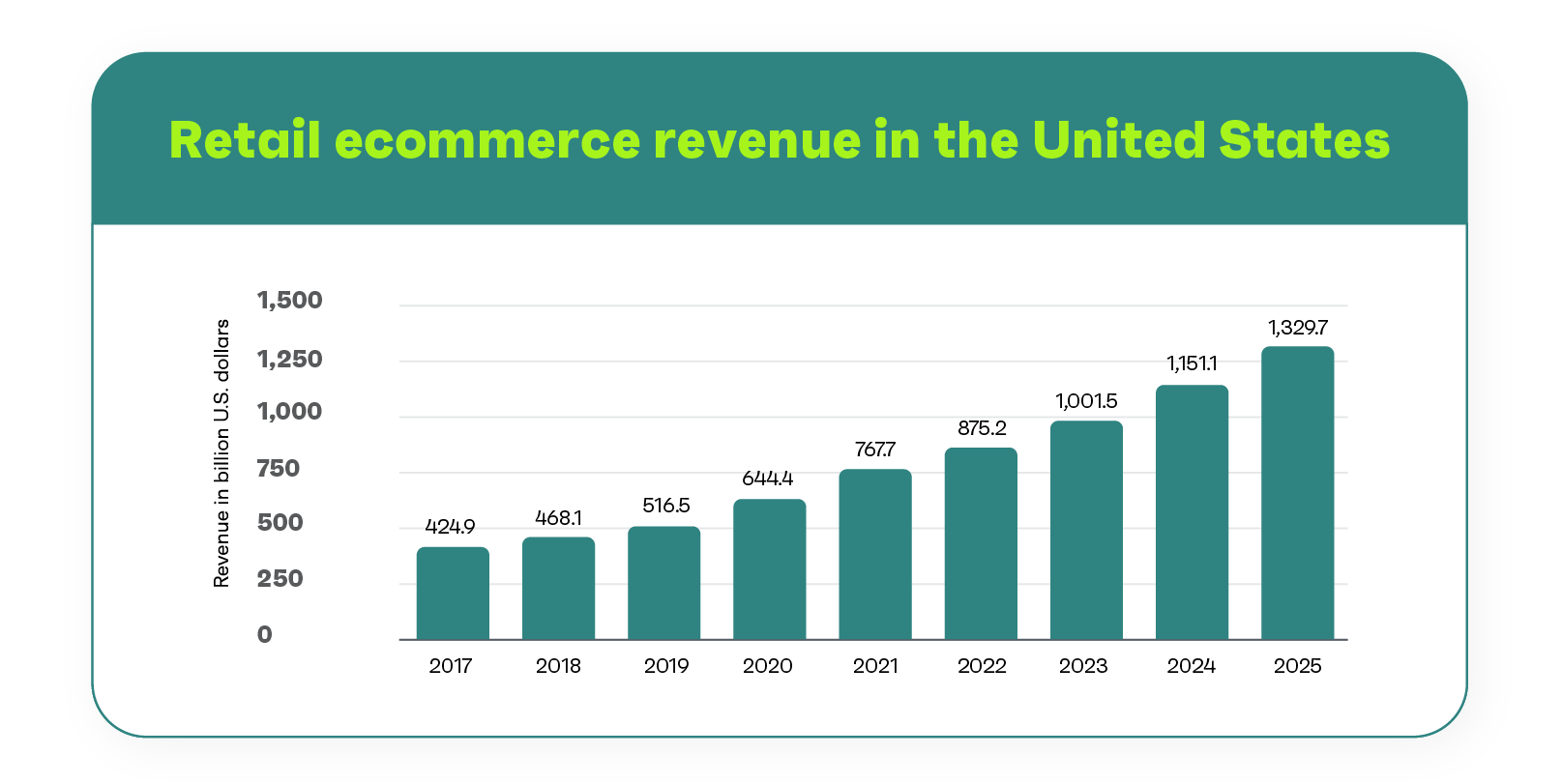
Though online retail sales have been increasing steadily in the USA for years to $768 billion in 2021, ecommerce statistics show that brick-and-mortar sales still make up the majority of retail sales in the country.
This trend is likely to continue, as the majority of Americans still prefer to shop in-store rather than online.
There are a number of reasons why Americans still prefer to shop in-store, including the ability to inspect and try before they buy, the convenience of being able to receive items immediately, and the social aspect of shopping with friends.
But this may change soon.
According to the latest ecommerce statistics, retail ecommerce sales will reach $1.3 trillion by 2025, when they’ll account for almost a quarter of all retail sales. Until then, the sales are expected to register double-digit growth each year.
These numbers show that the growth of retail ecommerce is still strong in the USA, and that businesses need to be prepared to take advantage of this channel by strengthening their ecommerce marketing strategies.
Shopping behavior ecommerce statistics
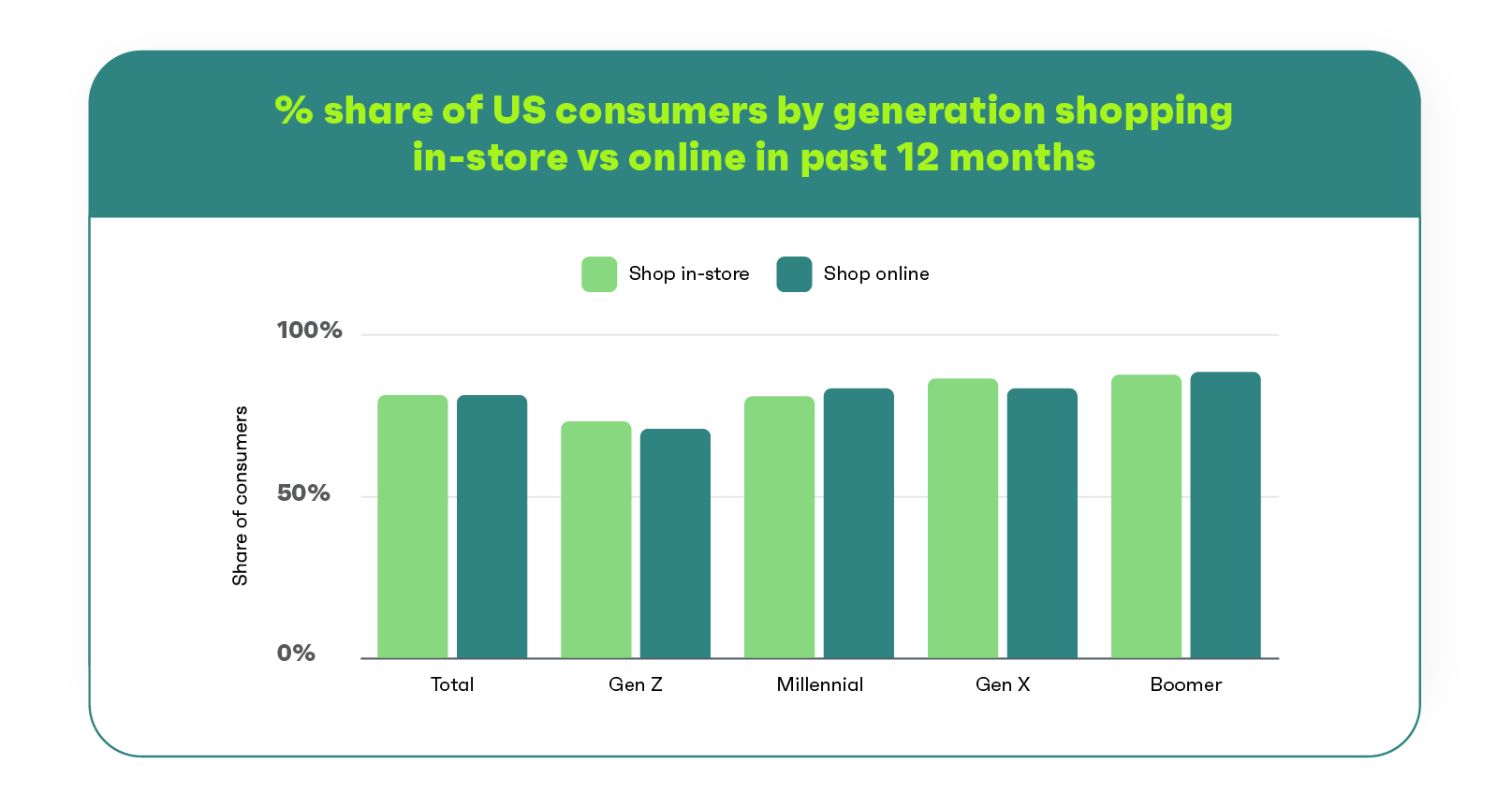
Despite the fact that most Americans (except Millennials) still prefer in-store shopping, ecommerce stores have a lot to celebrate. A large number (36%) of Americans prefer to do small grocery shopping online every week. At the same time, 57% of Americans turn to ecommerce stores for holiday shopping. The most commonly bought items online include clothing, shoes, movies, music, games, and books, followed by electronics, accessories, and food.
The reason for this is simple—direct delivery to home. It’s the #1 reason for 54% of consumers. A large number of them also do so to avoid large crowds.
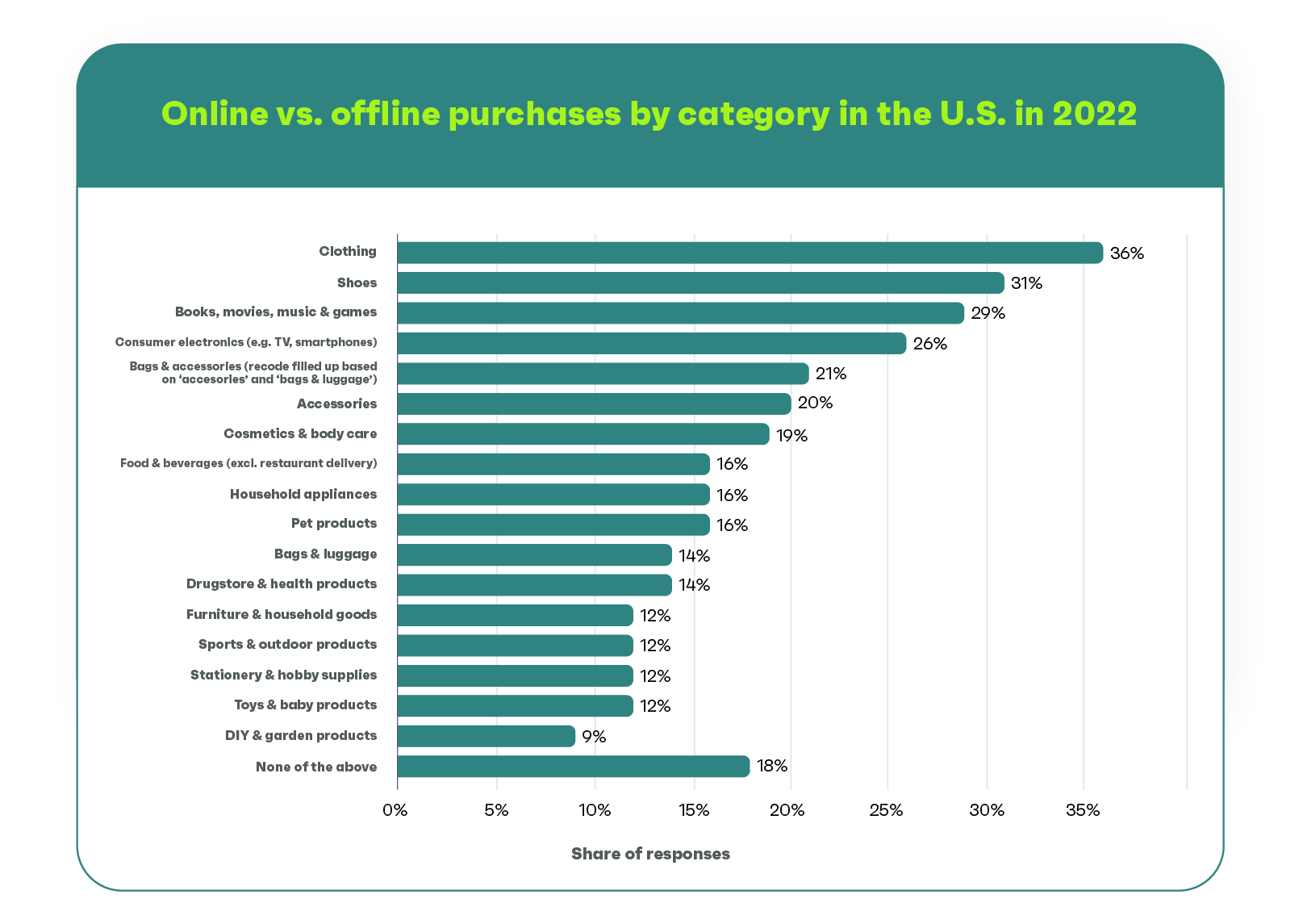
And guess what?
Most of this shopping is done through smartphones, with 51% of consumers opting to complete their purchases online.
That said, most consumers (85%) ended up abandoning their carts in the second quarter of 2022. This is an important ecommerce statistic you need to know, as it can lead to a drop in your revenue. At the same time, remedying this issue could boost it further.
There are a number of reasons why shoppers may abandon their carts, including high shipping costs, difficulty navigating the website, and simply changing their minds about the purchase.
Some of the things you can do to help change their mind include offering free shipping, providing seamless website navigation, and providing discounts.
A powerful strategy that can come in handy to woo back cart abandoners is . It can yield a year-on-year conversion rate of 13%.
You can also use popups, forms, wheel of fortune, and teasers to attract cart abandoners back. Another effective way is to integrate abandoned cart SMS marketing with your retargeting and cart recovery emails.
Mobile ecommerce statistics
As mentioned earlier, people are increasingly using their mobile phones to shop online. While in 2017, mobile’s share of ecommerce sales was 8.9%, it was estimated to account for 72.9% of global ecommerce sales in 2021.
Additionally, the average time Americans spend on their mobile phones increased to 4 hours and 23 minutes in 2021. This excludes the time spent talking over the phone.
Interestingly, desktop ecommerce has a higher conversion rate (3.8%) compared to mobile phone sales (2.3%) in the USA, per the latest ecommerce statistics.
Despite this, mobile commerce sales in the USA reached $360 billion in 2021 and are expected to reach $710 billion by 2025.
This trend is expected to continue as online retailers are investing heavily into this space, with new features being launched every day to make it easier for shoppers to buy products from their phones.
One thing that these numbers highlight is that an integrated approach is required to target consumers in the USA. Instead of taking a single path to shopping online, consumers leverage different channels, right from desktop and email marketing to in-store purchases.
As different consumers react and respond to different types of offers, messages, and channels, ecommerce marketers will need to fine-tune their integrated omnichannel marketing approach.
Digital payment ecommerce statistics
At $1.19 trillion, digital commerce accounts for the largest chunk of digital payments made in the US. The total transaction value of digital payments is expected to reach $1.76 trillion in 2022.
Compared to Asian countries, the western markets have been slower to switch to new digital payment solutions. The fact that China recorded the highest digital transaction value in 2022 proves the point.
Globally, digital and mobile wallets have emerged as the latest payment trend in ecommerce. They are becoming more popular than cards, which is a sign that people prefer to use them for online purchases.
Ecommerce statistics show that digital and mobile wallets accounted for roughly half of global ecommerce payment transactions in 2021, and their share will increase to 53% by 2025.
This is due to the widespread use of smartphones, which allow people to make payments from their phones without having to carry cash or cards. Digital wallet providers also offer rewards programs, loyalty points, and other features that traditional retailers cannot provide.
Although credit cards are the second most popular ecommerce payment method, their usage is set to decline in the future.
However, shoppers in the USA continue to prefer credit and debit cards (82%), while most Europeans (80%) say Alipay and PayPal are the preferred payment modes.
What does this mean for ecommerce retailers?
Different ecommerce payment methods can attract various kinds of customers and boost sales for you. Offering a variety of payment options gives customers the flexibility they need to make a purchase, and it can also make your store more appealing to a wider range of shoppers. Try to offer a mix of credit and debit cards, e-wallets, and possibly cryptocurrency.
Covid-19 ecommerce statistics
As the Covid-19 pandemic began to take hold in early 2020, many businesses were forced to close their doors and move their operations online. For retail sales, this meant a shift from in-person shopping to ecommerce.
In Canada, the U.K., and the USA, the share of ecommerce transactions grew significantly during this period. In particular, the drugstore segment’s ecommerce sales alone accounted for 16% of total retail sales.
The other key ecommerce statistics during this period were that the traffic to ecommerce websites increased by 12% while there was a year-over-year (YoY) increase of 40% in the number of unique digital shoppers. Unique page views and order count also rose to 96% and 88% percent, respectively, in April 2020.
Our ecommerce statistics also show that both email open rates and click-through rates increased significantly during and after the pandemic.
Notably, the pandemic also led to a significant increase in online purchases through social media, particularly in the Middle East, where the increase was 93 percentage points. This was followed by North America at 68 and Europe at 59 percentage points.
There are a number of factors that have contributed to this trend. Firstly, social media platforms such as Facebook and Instagram have made it easy for users to discover and purchase products without having to leave the app.
Secondly, many businesses have been using social media to promote their products and offer special deals and discounts, which has encouraged more people to make purchases online. Finally, the pandemic meant that people were spending more time at home and were, therefore, more likely to turn to online shopping as a way to pass time.
To make the most of this opportunity, Ron Dod, CMO at Visiture, advises marketers to find out which social channels their target audience prefers and to experiment with new ways, tools, and technologies to connect with them.
Similarly, Omnisend’s Greg Zakowicz advises marketers to be mindful when using email marketing during challenging times such as the pandemic. This involves understanding the audience’s perspective and taking a softer tone with the email copy. He also advises tweaking the content of popups, forms, and other messages that run in the background to align with your overall messaging.
Fashion ecommerce statistics
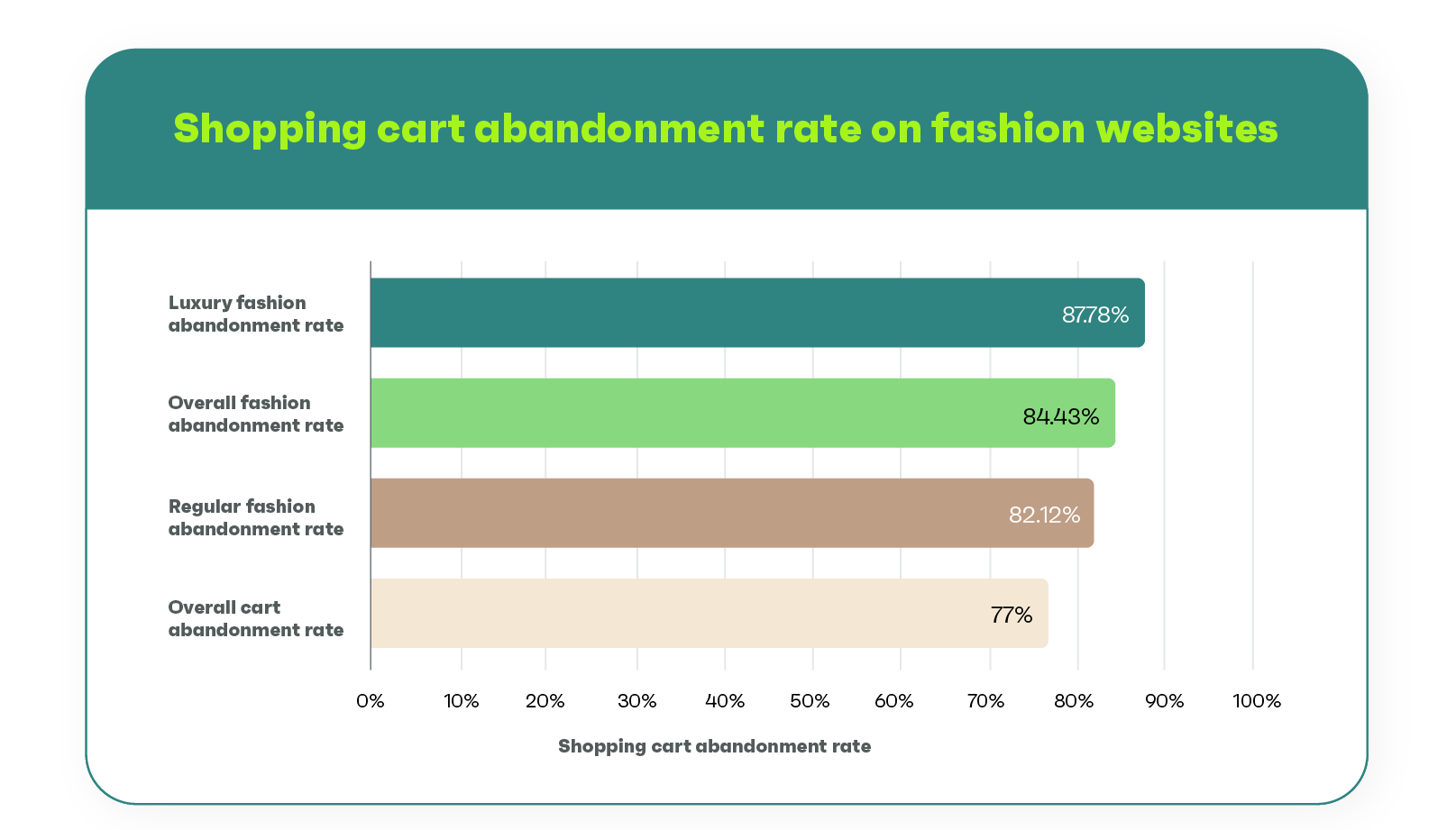
Ecommerce has enabled a whole new avenue for consumers to have the convenience of purchasing clothes when and where they want. It has led to fashion ecommerce becoming a $752.5 billion industry globally in 2020.
It’s growing quickly too.
In fact, by 2025, the online clothing industry is slated to reach $1.2 trillion, while fashion, the largest B2C ecommerce segment, will grow at a rate of 9.1% each year to reach $1.164,7 billion by 2025.
And in this rapidly changing industry, it’s important for fashion retailers to keep pace with the ecommerce statistics in the fashion industry. The top positive fashion ecommerce trends to note are the significant growth in clothing and apparel ecommerce, and the rise in second-hand shopping.
Clearly, the convenience that online shopping offers is the key driver of this trend. Online buying also allows customers to buy clothes that are not available in their local stores and get them delivered at their doorstep.
It is also worth noting that although the Asian market is currently the largest in terms of ecommerce fashion revenue, the North American market is not far behind. The latest ecommerce statistics show that North America might overtake Asia in 2022. This is due to the fact that the ecommerce market is growing at a faster rate in North America than it is in Asia.
In 2021, the fashion ecommerce industry generated $200.8 billion in North America, and that figure is expected to reach $331.7 billion by 2025.
Another interesting trend that’s emerging in the fashion industry across the USA and Europe is the preference for second-hand fashion.
Ecommerce statistics from 2020 show that one out of five consumers made second-hand fashion purchases, and this share is expected to go up to 27 percent by 2023.
That said, everyone doesn’t prefer ecommerce.
About 47% of consumers across the globe said that they do not want to shop online for clothes because they cannot see the products in person. Not being able to try out clothes before buying is another reason why 43% of consumers refrain from shopping online for clothes.
At the same time, cart abandonment rates on fashion websites continue to be higher than average abandonment rates for all ecommerce sites at 84.4%. The rates are higher at 88% for luxury fashion websites.
To attract cart abandoners, you will need a smart fashion ecommerce strategy. This includes reaching out to the abandoners and getting them back to your website to complete their purchases.
To get a jumpstart on your ecommerce business, you should implement an omnichannel strategy. This starts with a marketing automation platform, which allows you to develop sophisticated email workflows as well as SMS and push notifications.
Using it, personalize your messages across all touchpoints, including popups and forms on your site. This can help you get a good chunk of business from this burgeoning industry.
Beauty and apparel ecommerce statistics
The beauty industry has traditionally been driven by brick-and-mortar purchases that accounted for 85% of all sales in this sector in the pre-Covid era.
However, sales significantly decreased during the pandemic, with brick-and-mortar stores closing due to local lockdown rules. This led to quick growth of the ecommerce industry in this segment.
Ecommerce statistics from 2022 show that 60% of online shoppers now start their purchase journey from Sephora or Ulta, while Amazon comes a close second.
There are a number of reasons why beauty and personal care products are particularly well-suited to ecommerce. First, many of these products are small and easy to ship, which makes them ideal for online retailers. Second, customers can often find a wider selection of products online than they can in brick-and-mortar stores.
And third, customers can often get better deals on beauty and personal care products online than they can offline. With all of these factors working in its favor, it’s no surprise that ecommerce sales in beauty and personal care are growing at a rapid pace. And as an increasing number of consumers turn to the internet for their beauty and personal care needs, this trend is likely to continue.
But beauty isn’t the only industry that’s picking pace online. Apparel is not far behind.
Globally, the apparel market volume is expected to reach 192,534.8 million pieces by 2026. Currently, in 2022, the per-person volume stands at 22 pieces.
Additionally, according to the latest ecommerce stats, the global apparel market will produce $1.53 trillion in revenue in 2022, and this is expected to grow at a CAGR of 5.48% between 2022 and 2026.
The largest segment in the apparel market is women’s apparel, with a volume of $0.79 trillion in 2022. Also, most of the sales in this sector (95%) will come from non-luxury goods.
This is a trend that’s prevalent in the USA as well. Inexpensive clothing, along with increasing use of social media and the internet, are the key drivers of apparel ecommerce growth.
It’s not surprising then that the market for apparel and accessories is worth a whopping $124 billion in the USA, and it’s only set to cross $150 billion by 2025. In 2022, the USA has the highest revenue in the sector at $312 billion with per-person revenue of $200.80.
If you are looking to invest in the personal care segment in the USA, the time is ripe!
Ecommerce revenue from this segment reached $53.7 billion in 2021, representing a $13 billion increase from 2020. This accounts for 11.38% of the total ecommerce market in 2021.
And this market is set to expand to $79.3 billion by 2025, making it the most profitable segment of the industry for those who invest in it today.
Social media ecommerce statistics
With over four billion active social media users, it’s no surprise that numerous ecommerce businesses are turning to social commerce to drive their revenues.
If the latest ecommerce statistics are anything to go by, social media channels are now the preferred shopping platform for many consumers in the United States. About 55% of online shoppers aged between 25 and 34 worldwide have made purchases through social media.
According to the available ecommerce statistics, social commerce has resulted in a revenue of $724 billion in 2022. This number is likely to reach $6.2 trillion in this decade at a CAGR of 30.8% until 2030.
This is an expected trend as social media offers an easy way for customers to connect with their favorite brands and retailers on a more personal level. They can follow their favorite companies and get updates on new products and sales. Shoppers can interact with brands and retailers through comments, likes, and shares. This makes the shopping experience more fun and engaging.
Most social media platforms also offer in-platform purchases, so consumers don’t need to leave the platform to complete their..
Source link


